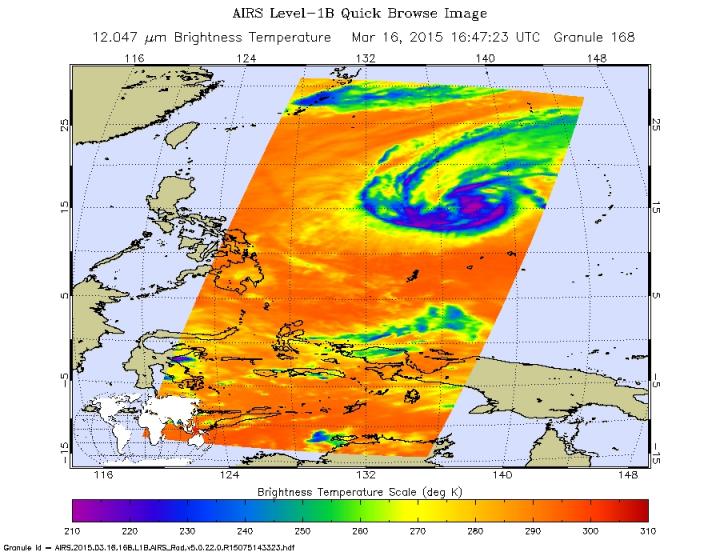NASA sees Tropical Cyclone Bavi losing steam

This false-colored image shows warming infrared temperature data of Tropical Cyclone Bavi's clouds on March 16 at 16:47 UTC, as seen by the AIRS instrument aboard NASA's Aqua satellite. Credit: NASA JPL
The Atmospheric Infrared Sounder or AIRS instrument that flies aboard NASA's Aqua satellite revealed warming infrared temperature data of Tropical Cyclone Bavi's clouds on March 16 at 16:47 UTC (10:47 a.m. EDT).
At 0900 UTC (5 a.m. EDT) on March 17, 2015 the Joint Typhoon Warning Center (JTWC) noted that “Recent animated enhanced infrared satellite imagery showed the system is stripped of any significant deep convection.”
That's as a result of moderate to strong (20 to 30 knot/23 to 34.5 mph/37 to 55.5 kph) southwesterly vertical wind shear.
The imagery showed a ragged low-level circulation center and cloud top temperatures had warmed over the previous 24 hours. Warming cloud tops indicate that the cloud tops are dropping and the storms are weakening.
Bavi has weakened to a depression with maximum sustained winds near 30 knots (35 mph/55 kph). Bavi was centered near 15.6 north latitude and134.5 east longitude, about 784 nautical miles (902 miles/1,453 km) east of Manila, Philippines. Bavi was moving to the west-northwest at 8 knots (9.2 mph/14.8 kph).
Bavi is moving to the west, tracking along the southern edge of a sub-tropical ridge (elongated area) of high pressure to the north. The JTWC expects Bavi to dissipate in the next day or two.
Media Contact
All latest news from the category: Earth Sciences
Earth Sciences (also referred to as Geosciences), which deals with basic issues surrounding our planet, plays a vital role in the area of energy and raw materials supply.
Earth Sciences comprises subjects such as geology, geography, geological informatics, paleontology, mineralogy, petrography, crystallography, geophysics, geodesy, glaciology, cartography, photogrammetry, meteorology and seismology, early-warning systems, earthquake research and polar research.
Newest articles

Trotting robots reveal emergence of animal gait transitions
A four-legged robot trained with machine learning by EPFL researchers has learned to avoid falls by spontaneously switching between walking, trotting, and pronking – a milestone for roboticists as well…

Innovation promises to prevent power pole-top fires
Engineers in Australia have found a new way to make power-pole insulators resistant to fire and electrical sparking, promising to prevent dangerous pole-top fires and reduce blackouts. Pole-top fires pose…

Possible alternative to antibiotics produced by bacteria
Antibacterial substance from staphylococci discovered with new mechanism of action against natural competitors. Many bacteria produce substances to gain an advantage over competitors in their highly competitive natural environment. Researchers…





















